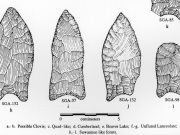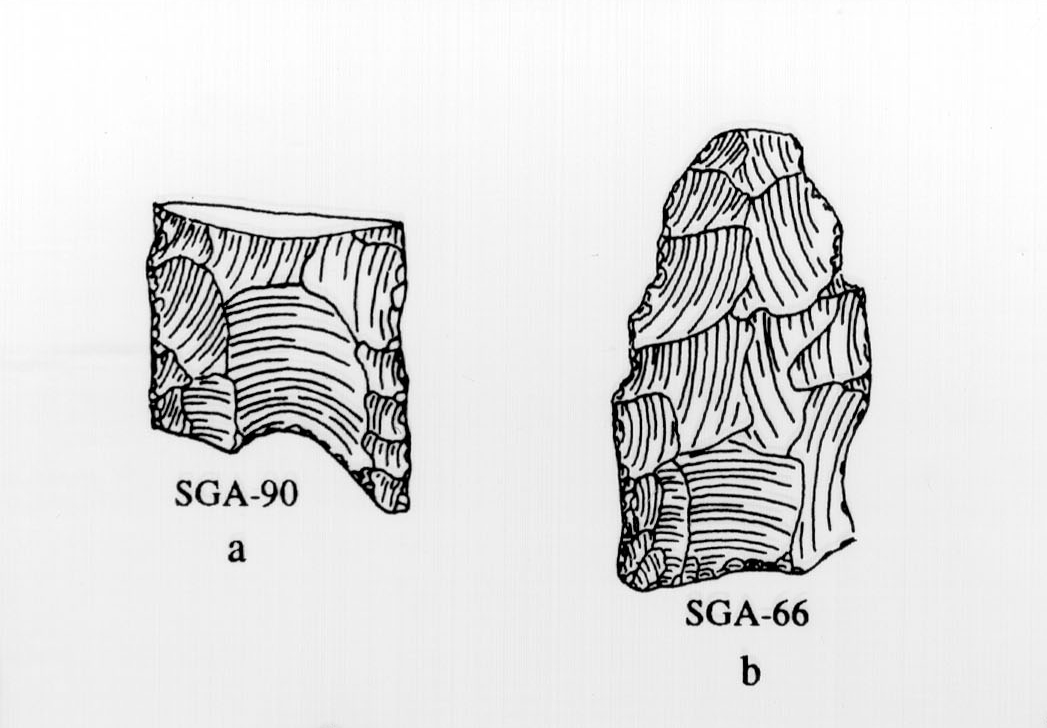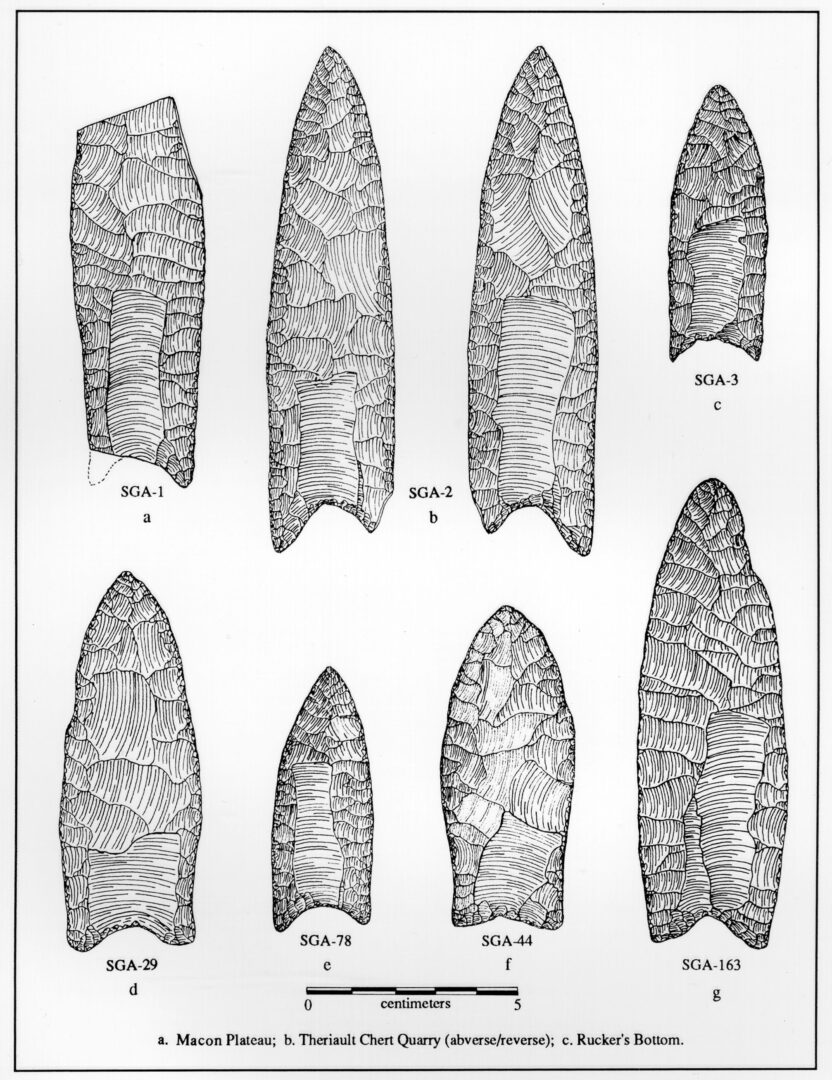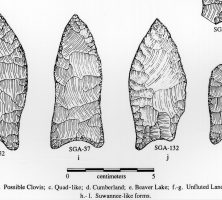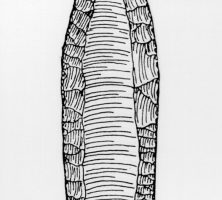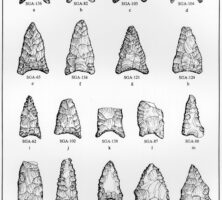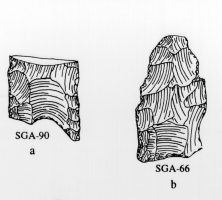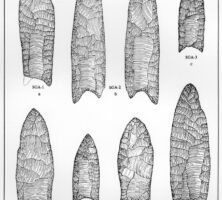The initial human settlement of Georgia took place during one of the most dramatic periods of climate change in recent earth history, toward the end of the Ice Age, in the Late Pleistocene epoch.
Exactly when human beings first arrived is currently unknown, although people had to have been present 13,250 years ago: distinctive artifacts of the Clovis culture (so named from the New Mexico town of Clovis, where the characteristic stone projectile points with a central groove were first unearthed) have been found at a number of locations across the state. The late glacial southeastern environment these first peoples encountered was markedly different from today’s environment. Sea levels were more than 200 feet lower than present levels, and the Atlantic Ocean and Gulf of Mexico shorelines were 100 or more miles seaward of their present locations. Global temperature was rising rapidly during the interval from 15,000 to 11,000 years ago, albeit with occasional sharp reverses, and the great continental ice sheets were retreating, causing the coastline to move rapidly inland.
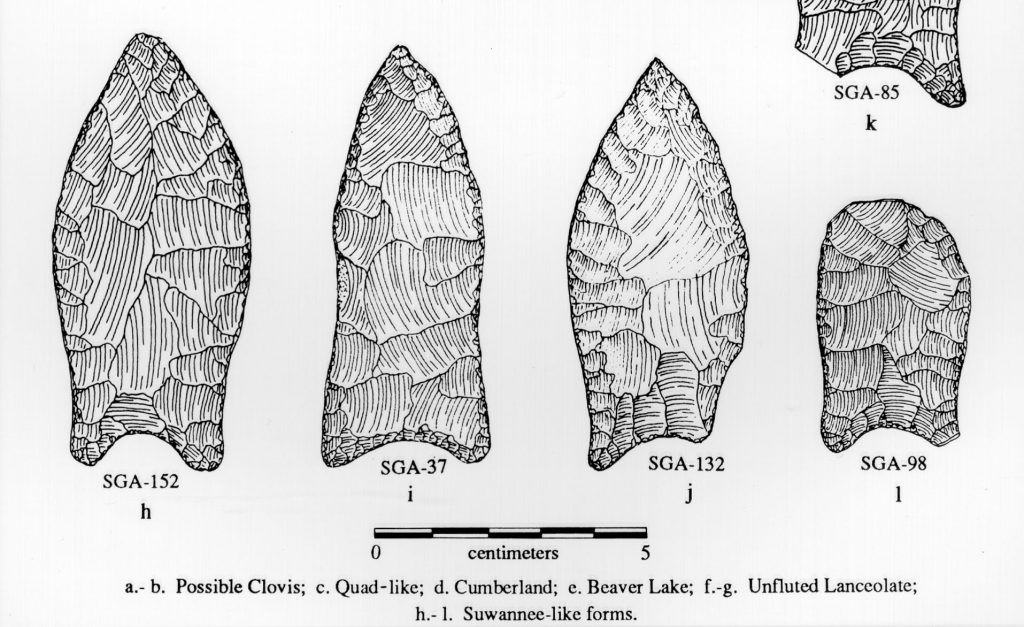
Courtesy of the University of Georgia Laboratory of Archaeology
During this interval massive extinctions of such animals as elephants, horses, camels, and other megafauna took place, and plant communities shifted location and composition in dramatic fashion. In north Georgia a spruce/pine boreal forest was replaced by northern hardwoods (oak, hickory, beech, birch, and elm), which in turn gave way to modern plant communities. Southern Georgia had an oak-hickory hardwood canopy that may have been in place throughout much of the previous glacial cycle. By the close of the Paleoindian Period, around 9000 or 8000 B.C., sea level was within a few meters of its present elevation, and climate and biota approached modern conditions. Only during the mid-Holocene (ca. 6000-2000 B.C.), however, did southern pine communities and extensive riverine cypress swamps begin to emerge in the Coastal Plain.
Chronology
Paleoindian occupations in Georgia have been provisionally grouped into three subperiods: Early (ca. 11000-9000 B.C.), Middle (ca. 9000-8500 B.C.), and Late (ca. 8500-8000 B.C.). People may have been present before the Early Paleoindian subperiod, but identifiable remains have not been found in the state, and their recognition anywhere in America is still in its infancy. Archaeologists recognize sites dating to each subperiod primarily by the presence of distinctive projectile points. The Early Paleoindian is characterized by Clovis and related projectile point forms. These forms have relatively large lanceolate (lance-shaped) points with nearly parallel sides, slightly concave bases, and single or multiple basal flake scars, or flutes, that rarely extend more than a third of the way up the body.
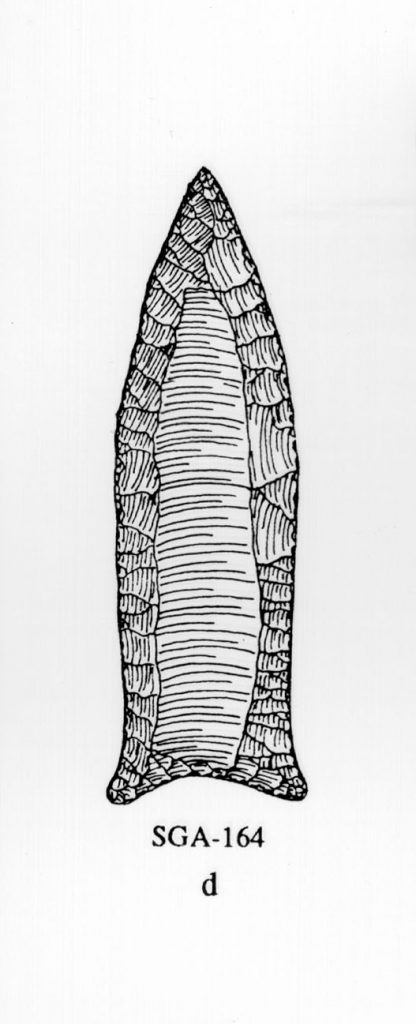
Courtesy of the University of Georgia Laboratory of Archaeology
The Middle Paleoindian features smaller fluted points, unfluted lanceolate points, and fluted or unfluted points with broad blades and constricted haft (handle) elements, such as the Simpson and possibly the Cumberland and Suwannee types.
From the Late Paleoindian subperiod come Dalton and related point types, which are characterized by a lanceolate blade outline, at least in the earliest stages of tool life, and a concave base that is ground on the lateral and basal margins and occasionally well thinned. Blade edges are frequently serrated and beveled, indicating extensive resharpening. The three major subperiods presumably coincide with human populations, those who initially explored and settled the region (Early Paleoindian), established regional population concentrations and cultural variants (Middle Paleoindian), and finally, adapted to modern conditions (Late Paleoindian).
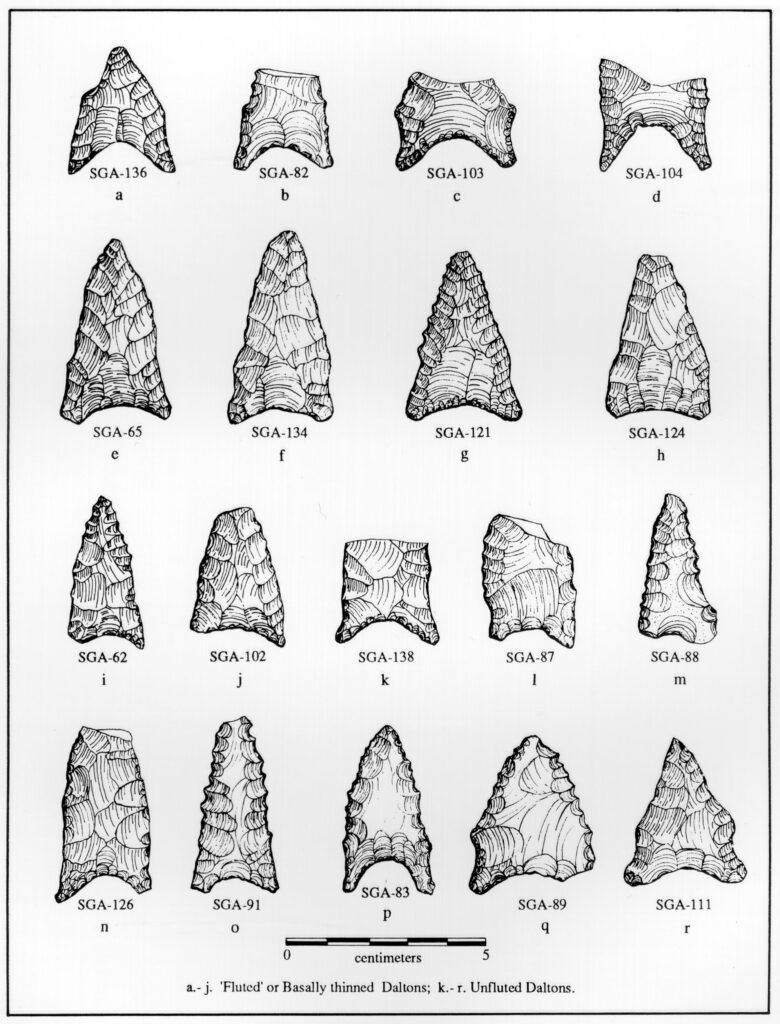
Courtesy of the University of Georgia Laboratory of Archaeology
Lifeways
Most likely, Paleoindians moved over large areas, on foot or by water, in small bands of twenty-five to fifty people. Their group ranges centered on stone quarries, shoals, or other particularly desirable environmental features. Although it is known they were hunter-gatherers, it is not known whether their diet primarily consisted of large game animals or a wide array of plant and animal species. In some parts of the country these peoples targeted elephants and other large game, but no evidence for this has yet been found in Georgia.
Early Paleoindian, Clovis culture groups are thought to have lived in central base camps for varying lengths of time. Once local resources were exhausted or depressed, they relocated to a new area, possibly quite some distance away. Several such moves may have occurred over the course of a year. Early Paleoindian toolkits have superbly made artifacts of chipped stone and carved bone—projectile points, scraping and engraving tools, cutting tools known to archaeologists as spokeshaves, and toward the end of the period, axlike adzes. Stone tools, particularly early in the period, were commonly made of the highest-quality materials.
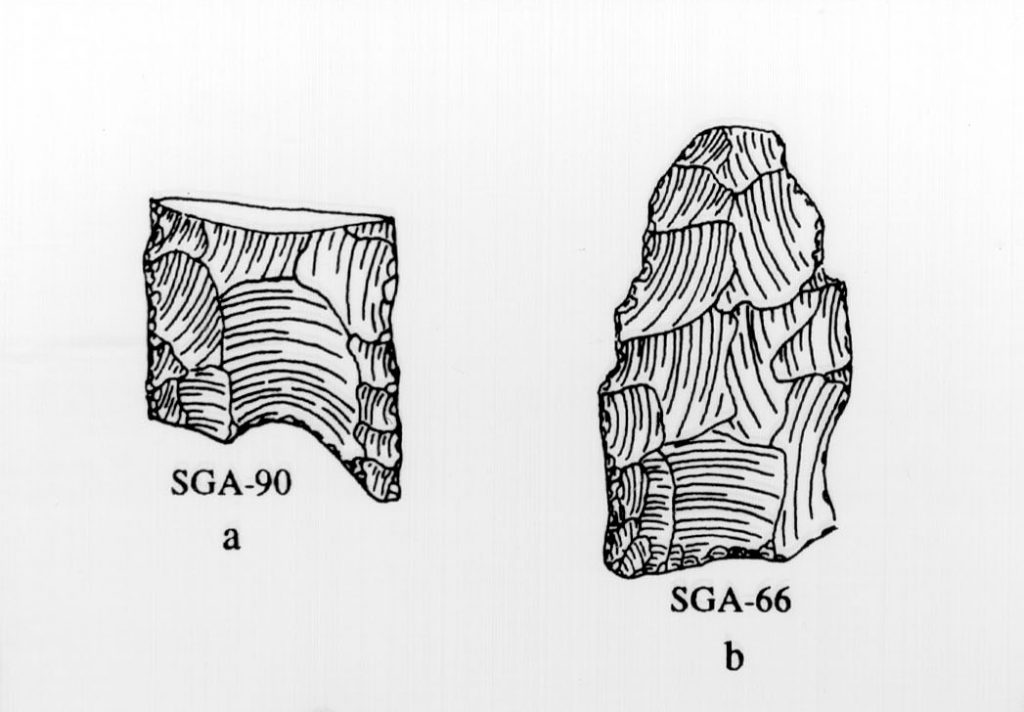
Courtesy of the University of Georgia Laboratory of Archaeology
Over the course of the Paleoindian era, comparatively fixed base camps gave way to more mobile foraging, with people readily and repeatedly moving their camps as they exhausted the food supply in their immediate area. Later Paleoindian assemblages were dominated by numerous short-term camps and more expedient assemblages, composed of tools that were casually made, used, and discarded. Formal, curated tools were less common, as was the use of high-quality stone, unless it happened to outcrop locally.
Sites in Georgia
No large Paleoindian sites have yet been excavated in Georgia, and much of our knowledge about these peoples is based on discoveries elsewhere in the region and beyond. The first fluted points were identified in Georgia in the mid-1930s, soon after the great age and distinctive appearance of these points became common knowledge among American archaeologists.
A Clovis point, along with a number of other stone tools, found at Macon Plateau in 1935 was one of the first Paleoindian points unearthed in eastern North America in stratigraphic context. The artifacts were heavily weathered, a condition considered to be a good indicator of an early site in Georgia. Only one fluted point was found at Macon Plateau, in spite of a massive excavation effort, and to date no site excavated in the state has ever produced more than one fluted point in good context.
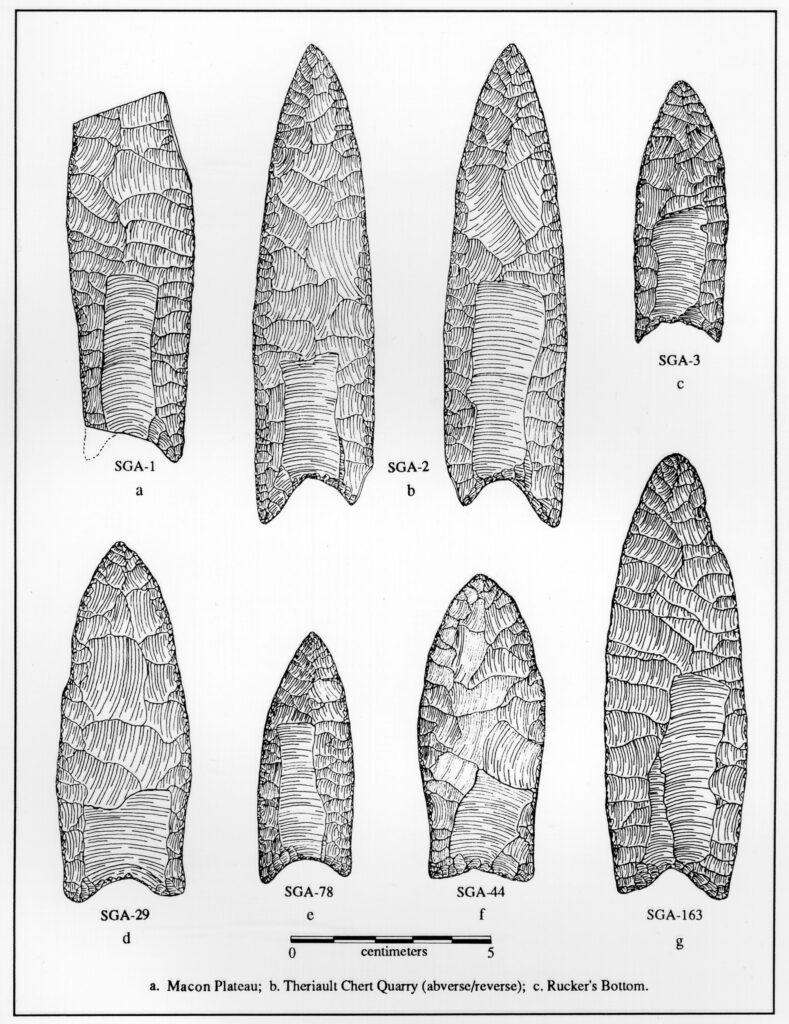
Courtesy of the University of Georgia Laboratory of Archaeology
Surface finds of Paleoindian artifacts, many in private collections, still constitute the bulk of the evidence for Paleoindian occupations in Georgia. Several hundred Paleoindian points are currently known from the state, although the number is tiny compared with the tens of thousands of later points that have been found. Of the more than 32,000 sites recorded in Georgia state archaeological site files by the year 2000, fewer than 200 have evidence for a Paleoindian occupation. These sites remain rare and, when found, should be protected.


